 |
| Shelley Duvall |
Shelley Duvall: The disappearance and return of a star pushed to her limits by the film industry
The actress, known for her role in ‘The Shining’ and as the visionary producer of a 1980s children’s series, returns to the big screen after two decades out of the public eye
Had her 2016 appearance on the controversial Dr. Phil show not been so alarming, Shelley Duvall, 73, could have just announced that she was returning to the big screen like any other talented actress coming back to Hollywood after a hiatus. It would have been similar to Cameron Diaz, who spent time away for a few years to focus on her family, and Debra Winger, who was fed up with a system that discards women after a certain age. But Duvall’s case is different. The last time we saw her on screen, she appeared haggard and was spouting disjointed ideas; she claimed that Robin Williams was still alive and “shape-shifting,” and that the sheriff of Nottingham from Robin Hood was threatening her.
That shameful spectacle was harshly criticized by Duvall’s colleagues and friends. “There should be laws to protect mentally ill people from TV talk show predators like Dr. Phil, who is exploiting Shelley Duvall for his own gain,” Mia Farrow tweeted. After the program aired, Vivian Kubrick (director Stanley Kubrick’s daughter) also condemned the interview and started a fundraising campaign to help the actress. “I think more and more people now realize how brutal the Hollywood system is and how people aren’t really taken care of even though the studio system has benefited greatly from their talent,” Kubrick stated.
Indeed, Duvall’s talent made the studios a lot of money. She played Wendy Torrance in The Shining (1980), probably her most recognizable role for younger generations. She was also director Robert Altman’s muse and became the brilliant producer of several successful adaptations of children’s stories, which made her a television star.
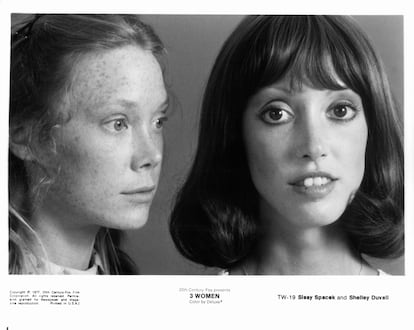
Sissy Spacek and Shelley Duvall in a scene from '3 Women' (1977).ARCHIVE PHOTOS (GETTY IMAGES)
Now, Duvall is returning to the movies at director Scott Goldberg’s insistence. In the new film, The Forest Hills, Goldberg reunites her with Dee Wallace (who played the mother in E. T. The Extra-Terrestrial (1982) and appeared as a scream queen in cult films from the 1980s, such as Howl!, Cujo and Critters) and another actor with an erratic career, former child star Edward Furlong of Terminator 2 and American History X.
Duvall has been out of the spotlight since 2003, when she starred in Manna from Heaven, alongside another horror legend, the recently deceased Louise Fletcher, who played Nurse Ratched in One Flew Over the Cuckoo’s Nest. Duvall lives on a ranch in her home state of Texas with musician Dan Gilroy (Madonna’s ex-boyfriend), who has been her partner since 1989. After a career spanning over three decades in Hollywood, Duvall returned home as if her time in Hollywood had been a mere blip.
Robert Altman’s muse
As a teenager, Duvall dreamt of becoming a scientist. She had also dabbled in modeling. Like so much in the entertainment industry, her start in acting was a fluke. After Robert Altman showed footage to explain why Duvall would be perfect in the role of Olive Oyl in his film Popeye, Don Simpson remarked, “I don’t want to fuck her, and if I don’t want to fuck her she shouldn’t be in this movie.” Altman himself told Peter Biskind of the incident in the latter’s book Easy Riders and Raging Bulls. But despite Simpson’s comments, Altman got his way (for his part, Simpson later said something similar about Debra Winger, disparaging her as the leading actress in An Officer and a Gentleman [1982]).
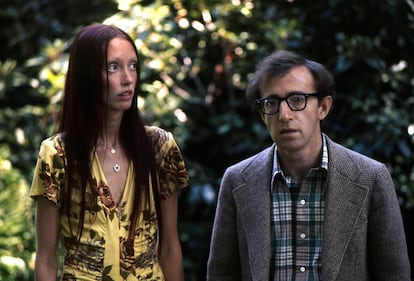
Shelley Duvall and Woody Allen in 'Annie Hall' (1977).MPTVIMAGES.COM
Ironically, the first role Shelley was ever offered was the lead in a porn movie. The second time acting was suggested to her, she was helping her first husband, artist Bernard Sampson, sell his work in Texas. Robert Altman was shooting Brewster McCloud (1970), and his crew was captivated by the future actress’s physique. That film marked the beginning of a partnership that would last for six more films: McCabe & Mrs. Miller (1971), Thieves Like Us (1974), Nashville (1975), Buffalo Bill and the Indians or Sitting Bull’s History Lesson (1976), 3 Women (1977), for which she won the Best Actress award at Cannes, and Popeye (1980).
Duvall had the era’s in-demand body type: she was tall, slim, and slightly gangly and had huge eyes with long eyelashes. She represented the sort of modern woman who was beginning to appear in fashion magazines, which made her the perfect choice for roles like the “transplendent” Rolling Stone journalist in Annie Hall (1977). In that film, she crossed paths with musician Paul Simon, who became her partner for two years until he left her for her friend Carrie Fisher. Simon broke up with Duvall at an airport on the same day she was on her way to London to start filming The Shining with Stanley Kubrick. Although she spent the 12-hour flight crying, it was nothing compared to what awaited her in England.
Going to hell with a genius
It didn’t take Duvall long to realize that Robert Altman and Stanley Kubrick worked in extremely different ways. The set of The Shining bore no resemblance to the familiar, carefree atmosphere of filming with the MASH director. In fact, Kubrick isolated her from the rest of the crew, while the movie’s star, Jack Nicholson, received her somewhat coolly (he felt that the role should’ve gone to the much more sensual Jessica Lange).
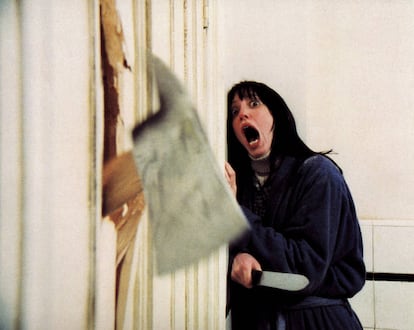 Shelley Duvall in a scene from 'The Shining.'UNITED ARCHIVES/IMPRESS (UNITED ARCHIVES / CORDON PRESS)
Shelley Duvall in a scene from 'The Shining.'UNITED ARCHIVES/IMPRESS (UNITED ARCHIVES / CORDON PRESS)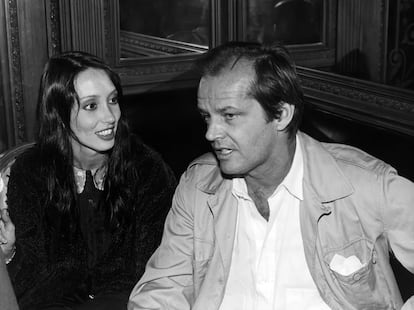 Shelley Duvall and Jack Nicholson, in New York in 1980.ROBIN PLATZER/IMAGES (GETTY IMAGES)
Shelley Duvall and Jack Nicholson, in New York in 1980.ROBIN PLATZER/IMAGES (GETTY IMAGES)Shooting The Shining took its toll on Duvall. “Going through day after day of excruciating work was almost unbearable,” Duvall said. “Jack Nicholson’s character had to be crazy and angry all the time. And in my character I had to cry 12 hours a day, all day long, the last nine months straight, five or six days a week. I was there a year and a month…” She added that “after a while, your body rebels. It says: ‘Stop doing this to me. I don’t want to cry every day.’ And sometimes just that thought alone would make me cry. To wake up on a Monday morning, so early, and realize that you had to cry all day because it was scheduled – I would just start crying. I’d be like, ‘Oh no, I can’t, I can’t.’ And yet I did it.”
Kubrick’s questionable treatment of Duvall included doing 127 takes to shoot the sequence in which she threatens Nicholson with a baseball bat; because of her nervous state, the tears in the scene were real. “It was a hell of a shoot but he got what he wanted out of me!” she said. “People love that scene!”
Despite being regarded as a classic horror film today, The Shining was not a hit when it was first released. The movie got a tepid reception from the public and critics alike. The attention the film garnered focused on the director. “After all that work, hardly anyone even criticized my performance in it, even to mention it, it seemed. The reviews were all about Kubrick like I wasn’t there.” Stephen King, the author of the novel on which the movie was based, hated the film from the start. He said that “Shelley Duvall as Wendy is really one of the most misogynistic characters ever put on film, she’s basically just there to scream and be stupid and that’s not the woman that I wrote about.” At the time, the newly founded Razzie Awards gave Duvall the Worst Actress award for that performance.
From horror movies to children’s television shows
While in London, she received a call from Altman to play Olive Oyl in the film version of Popeye (1980), which starred Robin Williams in the titular role. The film’s production was chaotic because of the massive quantities of drugs and alcohol on the set; while filming in Malta, the police intercepted producer Robert Evans’s suitcases, which were so full of drugs that only Secretary of State Henry Kissinger’s intervention prevented an international incident. Yet after her experience with Kubrick, Duvall has fond memories of it.

Duvall’s next idea was perhaps the best of her career. She saw the potential of the new cable television channels and focused on a relatively underserved niche: children’s programming. The actress decided to reinterpret the classics of children’s and young adult literature with an adult brand of humor to make the shows accessible to all audiences. She put together a list of actors including Robin Williams, Jeff Bridges, Mick Jagger, Liza Minnelli and Vanessa Redgrave and directors such as Francis Ford Coppola and the then-unknown Tim Burton, with whom she later shot the short film Frankenweenie (1984). The result was Faerie Tale Theatre, a show that aired between 1982 and 1987 and achieved worldwide success.
An inglorious farewell
As she concentrated on producing her show, her film roles became increasingly sporadic: she appeared in Terry Gilliam’s The Heroes of Time (1981), in Roxanne (1987) alongside Steve Martin and in Jane Campion’s The Portrait of a Lady (1996). Shortly after that film, she left Hollywood. In 2003, following her last role in the independent film Manna from Heaven, Duvall simply disappeared. She returned to her native Texas for the next two decades (the public only learned about this recently through a long interview she did with The Hollywood Reporter) and was overwhelmed by financial problems (she doesn’t go into further detail). During this time, she fell out of touch with both the film industry and her own family (her father died in the 1990s, her mother passed away during the pandemic, and she doesn’t have much of a relationship with her three siblings).
She broke her radio silence with an unfortunate interview on Dr. Phil McGraw’s show in 2016. “I found out the kind of person he is the hard way,” she told The Hollywood Reporter. “My mother didn’t like him either. A lot of people, like Dan [Gilroy], said, ‘You shouldn’t have done that, Shelley.’” Her partner didn’t know that she was scheduled to appear on the show.
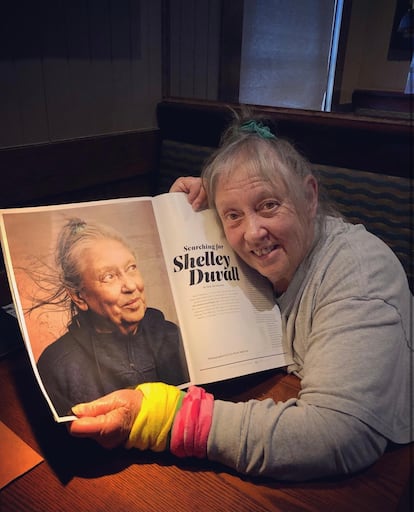
The only positive aspect of Dr. Phil’s television intervention was that the world learned that Duvall was still alive. Lee Unkrich, the director of Toy Story 3 (2010) and Coco (2017), was a fan of The Shining; at the time, he was finishing a book about the film. He had been looking for Duvall for years and contacted her. After their journey together, he discovered that “she could be gripped by anxiety attacks or meander into unsettling descriptions of alien-surveillance programs. But she also could converse for long, coherent stretches and conjure up the slightest details about her life and of her career, of which she remains very proud. "
Duvall’s return to the screen isn’t the only good news 2022 had in store for her. In March of this year, in light of the reports of the abuse Duvall faced on the set, the Razzies acknowledged their grave error in giving her performance in The Shining their Worst Actress award. Duvall’s suffering on Kubrick’s set is not an isolated case; it is similar to Kim Basinger’s experience in 9½ Weeks (1986) and Maria Schneider’s in Last Tango in Paris (1972). In all three cases, the directors dangerously crossed a line in order to wring their ideal performances out of the actresses, seriously affecting the performers’ health in the process. Not all of them could overcome the aftermath of these episodes. In that sense, although it is hard to believe, Shelley Duvall’s story has a happy ending by Hollywood standards.


No comments:
Post a Comment